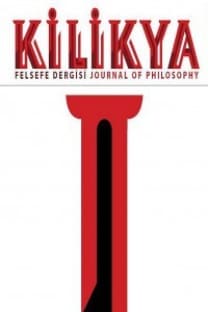WITTGENSTEIN’IN BİRİNCİ DÖNEM DÜŞÜNCELERİNDEKİ RESİM KURAMI VE ANLAMLA İLGİLİ SORUNLAR
THE PROBLEMS CONCERNING PICTURE THEORY AND MEANING IN WITTGENSTEIN’S EARLY PHILOSOPHY
___
- Altınörs, A. (2003). Dil Felsefesine Giriş. İstanbul: İnkılâp Yayınları.
- Black, M. (1964). A Companion to Wittgenstein’s Tractatus. London: Cambridge University Press.
- Çüçen, A. K. (2009). Klasik Mantık. Bursa: Asa Kitabevi.
- Demir, Ö. (2000). Bilim Felsefesi. Ankara: Vadi Yayınları.
- Descartes, R. (2007). Felsefenin İlkeleri (M. Akın, Çev.). İstanbul: Say Yayınları.
- Fogelin, R. J. (2002). Wittgenstein. New York: Routledge.
- Glock, H. J. (2005). A Wittgenstein Dictionary. Oxford: Blackwell Publishing.
- Grayling, A. C. (1996). Wittgenstein, A Very Short Introduction. New York: Oxford University Press.
- Grünberg, T. (2006). Anlam Kavramı Üzerine Bir Deneme. İstanbul: Yapı Kredi Yayınları.
- Hadot, P. (2011). Wittgenstein ve Dilin Sınırları (M. Erşen, Çev.). Ankara: Doğubatı Yayınları.
- İnan, İ. (2013). Dil Felsefesi. İstanbul: Anadolu Üniversitesi Yayınları.
- McGinn, M. (2007). Elucidating the Tractatus. New York: Oxford University Press.
- Monk, R. (2005). How to Read Wittgenstein. London: Granta Books.
- Morris, M. (2008). Wittgenstein and the Tractatus Logico-Philosophicus. New York. Routledge.
- Pears, D. (1970). Wittgenstein. New York: Viking Press.
- Russell, B. (2000). Felsefe Sorunları (V. Hacıkadiroğlu, Çev.). İstanbul: Kabalcı Yayınevi.
- Sluga, H. (2011). Wittgenstein. Oxford: Wiley-Blackwell.
- Soykan, Ö. N. (2002). Wittgenstein Felsefesi: Temel Kavram ve Sorunlar. Cogito, 33, İstanbul: Yapı Kredi Yayınları.
- Soykan, Ö. N. (2006). Wittgenstein Yaşamı Felsefesi Yapıtları. İstanbul: MTV Yayıncılık.
- Tepe, H. (2003). Platon’dan Habermas’a Felsefede Doğruluk ya da Hakikat. İstanbul: İmge Kitabevi Yayınları.
- Wittgenstein, L. (2000). Felsefi Soruşturmalar (D. Kanıt, Çev.). İstanbul: Küyerel Yayınları.
- Wittgenstein, L. (2001). Tractatus Logico-philosophicus (O. Aruoba, Çev.). İstanbul: Yapı Kredi Yayınları.
- Wittgenstein, L. (2000). Felsefi Soruşturmalar (D. Kanıt, Çev.). İstanbul: Küyerel Yayınları.
- Yayın Aralığı: 2
- Başlangıç: 2014
- Yayıncı: Eray Yağanak
PYRRHUS İLE CINEAS’TA TASARI VE AŞKINLIK TEMELİNDE SIMONE DE BEAUVOIR’IN CARPE DIEM ELEŞTİRİSİ
İNSAN ETKİNLİĞİNİN DOĞASI: ARENDT’İN MARX ÜZERİNE GÖRÜŞLERİNİN ELEŞTİREL BİR DEĞERLENDİRMESİ
G. W. F. HEGEL’İN ESTETİK ÜZERİNE DERSLERİ VE SANATIN SONUNA İLİŞKİN TEZLER
TIP ETİĞİNDEN BİO-ETİĞE: FRITZ JAHR
KIERKEGAARD’NUN ÖZNEL-NESNEL HAKİKAT AYRIMI TEMELİNDE TEKİL BİREY ANLAYIŞI
İNSAN, İNSANCILLIK (HÜMANİZM) VE İNSAN HAKLARI: İNSANCILLIK ELEŞTİRİSİ ÜZERİNE
DOĞRUDAN ÇIKARIMLARDAKİ BAZI MANTIKSAL EŞDEĞERLİK İLİŞKİLERİ
WITTGENSTEIN’IN BİRİNCİ DÖNEM DÜŞÜNCELERİNDEKİ RESİM KURAMI VE ANLAMLA İLGİLİ SORUNLAR
ANLAMIN DOĞASI VE RUHBİLİMSELCİ YAKLAŞIM SORUNU
